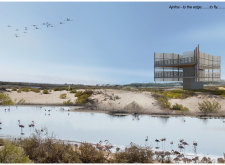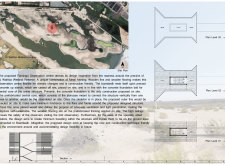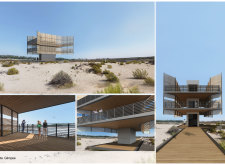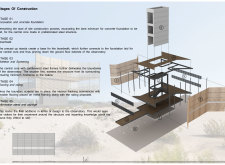5 key facts about this project
The primary function of the Flamingo Observation Centre is to provide a vantage point for visitors to observe the vibrant birdlife inhabiting the wetlands, particularly the flamingos, which are indigenous to the area. The design facilitates interaction between visitors and the natural surroundings, allowing for unobtrusive wildlife observation that minimizes disturbance to the ecosystem. The project emphasizes a commitment to conservation by situating the building on stilts, effectively raising it above the wetlands. This elevated design not only preserves the habitat below but also offers visitors expansive views across the landscape.
Architecturally, the Flamingo Observation Centre comprises key design elements that contribute to its unique character. The structure features a central core that acts as the support system for the cantilevered metal framework. This approach allows for a free-flowing, open space devoid of obstructive columns, creating an uninterrupted experience for users. The use of metal framing is notable not only for its strength and durability but also for its ability to lend a modern aesthetic to the design.
Adding warmth and a sense of intimacy to the structure, wooden fins encase the building’s edges. These fins serve a dual purpose; they provide essential shade from the harsh sun while also facilitating natural airflow through the space. The choice of using wood contributes to the organic feel of the architecture, creating a visual dialogue between the built environment and the natural landscape. Additionally, the flooring throughout the observation area is wooden, enhancing the connection to nature and inviting visitors to engage directly with their surroundings.
The construction methodology reflects a careful consideration of sustainability and efficiency. The project incorporates prefabricated components, which streamline the construction process while reducing waste. This method not only accelerates assembly but also aligns with environmentally conscious practices, minimizing the overall ecological footprint of the building process.
Among its many unique features, the Flamingo Observation Centre’s connection to the landscape stands out. The extensive boardwalks surrounding the structure provide visitors with easy access to various observation points without compromising the integrity of the wetlands. This is particularly important, as it ensures that the design respects local flora and fauna while promoting environmental awareness.
As visitors approach the building, they are welcomed by information stands and signage that educate them about the significance of the wetland ecosystem. This aspect of the design highlights the project’s function as a learning hub, fostering a greater understanding of conservation among the public. Engagement with nature is further enhanced through thoughtfully designed viewing platforms that allow for intimate interactions with wildlife while ensuring visitor safety.
In summary, the Flamingo Observation Centre embodies a contemporary architectural approach that marries functionality with ecological mindfulness. By prioritizing an unobtrusive design that harmonizes with its surroundings, the project facilitates deep engagement with the natural world. Its use of sustainable materials and innovative construction techniques underscores a commitment to environmental responsibility. The integration of educational resources demonstrates the project’s role in fostering a culture of conservation and appreciation for the delicate ecosystems of the wetlands.
For those interested in a more comprehensive understanding of this architecture project, exploring the architectural plans, sections, and designs will provide deeper insights. Delve into the unique architectural ideas that make the Flamingo Observation Centre not only a remarkable observation point but also a significant contribution to the conversation surrounding environmental conservation in architecture.


























